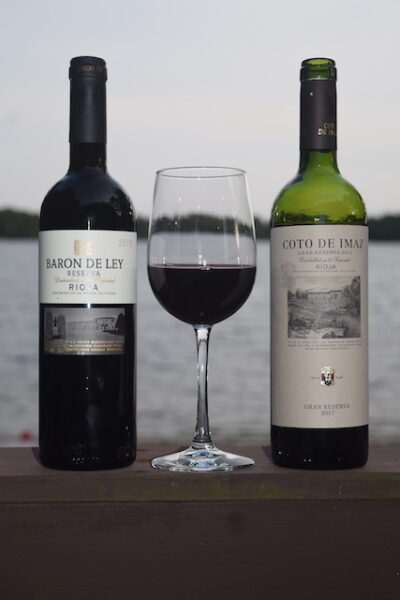From red wines to whites in Spain’s Rioja region

(Editor’s note: As we approach Labor Day, Monday, Sept. 2, we at Westfair thought it was a good time to reintroduce you to some of our columnists, who also labor as small business owners. Here meet Doug Paulding, who has turned a love of the land into South Salem-based Eager Beaver Tree Service and a career as a wine and spirits writer, including for Westfair: )
One of my early international wine press trips took place a couple of decades ago in the Navarra wine region of northern Spain. I was enchanted by Spanish wines and, after five subsequent trips to various Spanish wine regions, my love of them and Spanish culture has only grown. I was recently invited to a wine luncheon at 44 & X restaurant in the Hell’s Kitchen section of Manhattan, where we would taste seven wines from El Coto winery in Rioja, just a short trip from adjacent Navarra.
Until recently, the Rioja wine region was known for producing big, hearty red wines. In 2010, the region authorized white wine production and the planting of Viura, Malvasia, Verdejo, Chardonnay, Sauvignon Blanc and Garnacha Blanca white grape vines, along with others, began. By now the vines and their roots have sufficiently matured to produce respectable, delicious white wines.
Rioja is north and east of Madrid, quite close to the Pyrenees Mountain range that runs from the Atlantic Ocean to the Mediterranean Sea, creating a natural border between France and Spain. The Pyrennees also provide some cooling breezes to slow grape maturation. Tempranillo is the region’s primary red grape, and its wines are capable of long aging times. The wine production rules in place throughout Spain in general and in Rioja in particular almost singularly guarantee greatness.
In some wine regions of the world, there are no requirements in place to call a wine a Reserve wine or a Grand Reserve wine. It’s just a subjective rating system with no rules. In Rioja, a Reserva wine requires 18 months of oak aging and another 18 months of resting in the bottle. Gran Reserva wines require 24 months of oak aging with a minimum of 36 additional months of aging. Many producers will hold their wines considerably longer than these minimum standards so the wine is optimized at release date. Additionally, Reserva and Gran Reserva wines are blind-tasted by a panel of judges to be certain they are worthy.
El Coto Winery saw its first harvest in 1970. Six years later, the first winery was born, with the original expanded and improved on many times since the mid-’70s. By 2004, El Coto had become the largest wine producer in Rioja and its labels are now available in 70 countries. But the real beauty here is the price-to-value ratio. The Coto de Imaz Reserva can be found in the United States for about $17 and the Gran Reserva at around $22. To put it in perspective, a California wine with this kind of wood aging and subsequent bottle resting would come to market well north of $100, with some considerably more expensive. And the time commitment required in Rioja makes it certain the producers will be using their best grape plots for their elite wines.
At the event, I was seated beside El Coto’s Technical Director Cesar Fernandez as we tasted through several wines. Our first wine was Baron de Ley Tres Viñas 2019 white wine made from Viura, Malvasia and Garnacha Blanca. With a straw color and a light-to-medium body, it was beautifully balanced. Great citrus, crisp and zesty, it was thirst-quenching and satisfying to the palate. We next tasted the Coto de Imaz Reserve from 2020. Tempranillo is the grape, showing a well-saturated appearance with bright red fruit leaning toward strawberry and cherry.
The Baron de Ley Reserva from 2019 was medium to full-bodied and well-balanced. This wine was showing a red and dark cherry essence that was pleasing to the palate.
The Cote de Imaz Gran Reserva from 2018 was our next pour. Showing dark fruit with hints of boysenberry and a seductive silkiness, it had what Fernandez pronounced “elegance and finesse.” This wine is highly recommended. We then moved to a 2017 Baron de Ley Gran Reserva with spicy dark cherry and blackberry and a long silky finish – also recommended. The 2021 La Renacida Cigales is made from grapes coming from a single vineyard planted in 1927. It showed a lovely spicy black cherry with hints of cedar and leather. And finally, we tasted the Museum Reserva Cigales from 2020 — a wonderful wine with a lingering finish.
Any and all of these wines would light up a dinner table or party. To say they are fairly priced is a substantial understatement. I know if I need to impress someone, a Reserva or a Gran Reserva from El Coto Winery performs way above its price. Look for them and don’t be shy about buying a few cases for the cellar.
Doug Paulding is an arborist, ski instructor and photographer as well as Westfair wine and spirits columnist. He and his brother Bob started Eager Beaver Tree Service in 1977 – three years before Doug graduated from the University of Massachusetts at Amherst with a Bachelor of Arts degree in philosophy. While Bob covers Cape Cod, Doug serves Fairfield and Westchester counties.
After receiving arborist certifications from New York, Connecticut, Massachusetts and the International Society of Arboriculture, he began writing regular tree-related columns in the Gardener’s Gazette and the Patent Trader, Northern Westchester’s largest paper. Additionally, he has worked as a tree consultant to insurance companies.
In his spare time, Doug is a Professional Ski Instructors of America (PSIA)-certified instructor and coaches alpine skiing at Killington, Vermont. He also reviews wines and spirits, writing for Sante magazine, a food and beverage magazine for industry professionals. He regularly takes photographs for his columns and Eager Beaver’s website.
Write him at doug@dougpaulding.com.